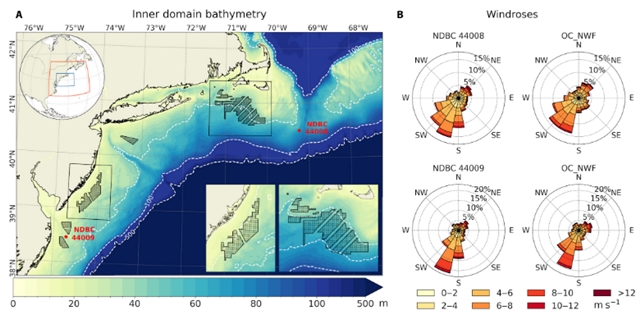近日,美国夏威夷大学Hyodae Seo团队报道了在季节性分层条件下,大规模海上风力发电场驱动的海面变暖和海洋对大气的反馈。该研究于2025年11月7日发表在《科学进展》杂志上。
海上风电场可能通过耦合的海洋-大气反馈引起上层海洋和近地表大气的变化。然而,人们对由海上风力发电场介导的海气相互作用仍然知之甚少。
通过对美国东海岸季节性分层条件的完全耦合的海洋-大气-波浪模式模拟,研究组发现,由于大型风电场测温仪,模拟的风应力累积减少导致海面变暖0.3°至0.4°C,混合层变浅。这种变暖推动了向上的热流,破坏了大气边界层的稳定性,增加了风压,部分抵消了唤醒引起的风亏。
这些起伏海洋相互作用影响近地气象学和空气 - 海洋流动,表明可能需要一种联合建模方法来评估海上风力发展的潜在海洋学影响。然而,海洋联轴对与涡轮机相关的高度或下游起伏的风的影响有限,从而对长期能源的影响很小。 这些发现表明,没有海洋联轴的模型可能适用于风能应用。
附:英文原文
Title: Sea surface warming and ocean-to-atmosphere feedback driven by large-scale offshore wind farms under seasonally stratified conditions
Author: Hyodae Seo, César Sauvage, Christoph Renkl, Julie K. Lundquist, Anthony Kirincich
Issue&Volume: 2025-11-07
Abstract: Offshore wind farms may induce changes in the upper ocean and near-surface atmosphere through coupled ocean-atmosphere feedbacks. Yet, the role of air-sea interactions mediated by offshore wind farms remains poorly understood. Using fully coupled ocean-atmosphere-wave model simulations for seasonally stratified conditions along the US East Coast, we show that simulated cumulative reductions in wind stress due to large-scale wind farm clusters lead to sea surface warming of 0.3° to 0.4°C and a shallower mixed layer. This warming drives upward heat fluxes, destabilizing the atmospheric boundary layer and enhancing wind stress, which partially offsets wake-induced wind deficits. These wake-ocean interactions influence near-surface meteorology and air-sea fluxes, suggesting that a coupled modeling approach may be necessary for assessing potential oceanographic impacts of offshore wind developments. However, ocean coupling exerts limited influence on winds at turbine-relevant heights or within downstream wakes, resulting in minimal impact on long-term energy. These findings suggest that models without ocean coupling may be adequate for wind energy applications.
DOI: adw7603
Source: https://www.science.org/doi/10.1126/sciadv.adw7603

